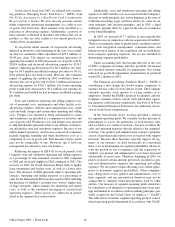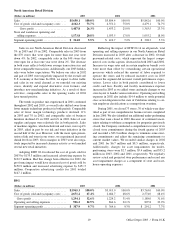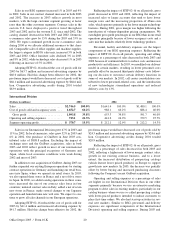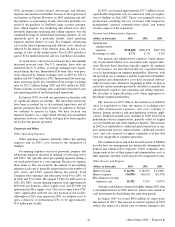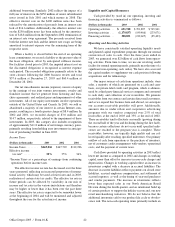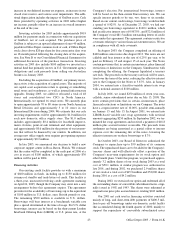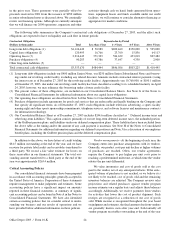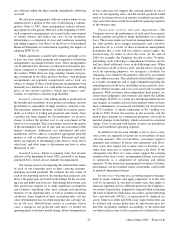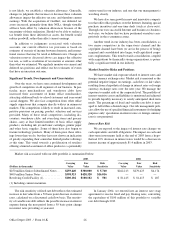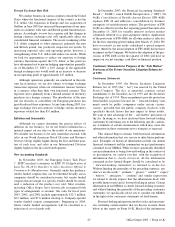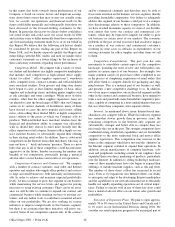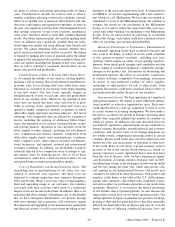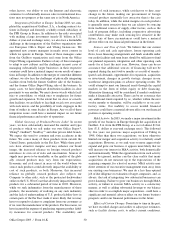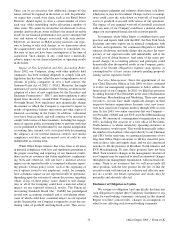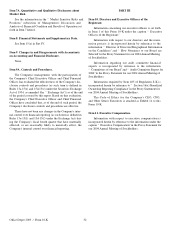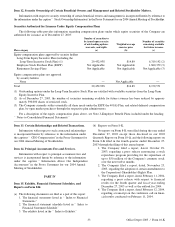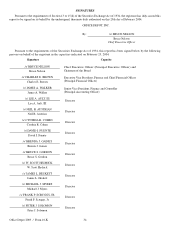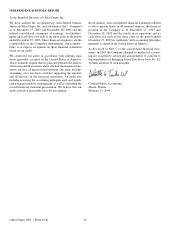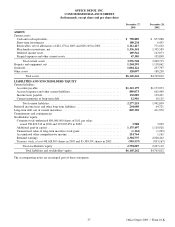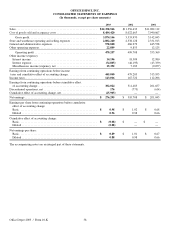Office Depot 2003 Annual Report Download - page 30
Download and view the complete annual report
Please find page 30 of the 2003 Office Depot annual report below. You can navigate through the pages in the report by either clicking on the pages listed below, or by using the keyword search tool below to find specific information within the annual report.in this report that looks towards future performance of our
Company is based on various factors and important assump-
tions about future events that may or may not actually come
true. As a result, our operations and financial results in the
future could differ materially and substantially from those we
have discussed in the forward-looking statements in this
Report. In particular, the factors we discuss below could affect
our actual results and could cause our actual results in 2004
and in future years to differ materially from those expressed in
any forward-looking statement made by us or on our behalf in
this Report. We believe that the following risk factors should
be considered by persons reading any part of this Report on
Form 10-K, and we hereby expressly qualify this Report and
future filings with the SEC (unless and until we modify these
cautionary statements in a future filing) by the inclusion of
these cautionary statements regarding future performance.
Competition—Retail: We compete with a variety of retail-
ers, dealers and distributors in a highly competitive marketplace
that includes such competitors as high-volume office supply
chains (so-called “ office supplies superstores”), warehouse
clubs, computer stores, contract stationers and well-established
mass merchant retailers. Even grocery and drug-store chains
have begun to carry at least limited supplies of basic office
supplies and technology items, including printer supplies such
as ink cartridges and toner cartridges. While most of these
retailers, other than the office supplies superstores, have not
yet elected to carry the broad range of SKUs that our Company
carries in its various channels of distribution, many of them
have elected to carry the most popular and fastest selling
items, often selling those limited SKUs at highly competitive
prices relative to the prices at which our Company sells its
products. Well-established mass merchant retailers have the
financial and distribution ability to compete very effectively
with us should they choose to enter more broadly into the
office superstore retail category, Internet office supply or con-
tract stationer business or substantially expand their offering
in their existing retail outlets. In addition, there is substantial
competition on the Internet from other merchants who may or
may not have a “ brick and mortar”presence. There is a possi-
bility that any or all of these competitors could become more
aggressive in the future, thereby increasing the number and
breadth of our competitors, potentially having a material
adverse effect on our business and results of our operations.
Competition—Contract and Commercial: We compete
with a number of contract stationers, mail order and Internet
operators and retailers who supply office products and services
to large and small businesses, both nationally and internation-
ally. In order to achieve and maintain expected profitability
levels, we must continue to grow this segment of our business
while maintaining the service levels and aggressive pricing
necessary to retain existing customers. There can be no assur-
ance we will be able to continue to expand our contract and
commercial business while retaining our base of existing cus-
tomers, and any failure to do so could have a material adverse
effect on our profitability. We are also working on various
initiatives to improve margin levels in this business segment,
but there is no assurance that these initiatives will prove suc-
cessful. Some of our competitors operate only in the contract
and/or commercial channels and therefore may be able to
focus more attention on the business services segment, thereby
providing formidable competition. Our failure to adequately
address this segment of our business could put us at a compet-
itive disadvantage relative to these competitors. In addition,
we have reached maximum capacity in some of our distribu-
tion centers that serve our contract and commercial cus-
tomers, which may be expected to impede our ability to grow
our business in certain areas of our markets. The economic
problems of the past several years have had an adverse impact
on a number of our contract and commercial customers,
resulting in some cases in cutbacks in expenditures of our
existing customers for office supplies and other items we sell
to them.
Competition—Consolidation: The past year has seen
movements to consolidate certain aspects of the competitive
landscape, including the entry of new and well-funded com-
petitors in certain aspects of our business. For example, two
major common carriers of goods have either completed or are
in the process of completing acquisitions of retail outlets that
will allow them to compete directly for packaging and ship-
ping business. This is a material part of our business as well,
and presents a new competitive challenge to us. In addition,
two of our major competitors, one in the retail segment and the
other in the contract and commercial business, have merged to
form a new and potentially more formidable competitive pres-
ence, capable of competing in a more unified manner than was
the case when these companies were separate entities.
Internet: As mentioned above, many Internet-based mer-
chandisers also compete with us. While this industry segment
has somewhat slower growth than in previous years, the
remaining competitors in the Internet-only segment are
substantially stronger and better able to compete than was
necessarily the case in the past. The stronger competitors have
established strong distribution capabilities and are formidable
competitors to the more traditional brick and mortar office
supplies superstores. This competition may increase in the
future as the companies which have survived the ‘shakeout’in
the Internet segment continue to expand their operations. In
addition, certain manufacturers of computer hardware, soft-
ware and peripherals, including certain of our suppliers, have
expanded their own direct marketing of products, particularly
over the Internet. In addition to selling technology hardware,
some of these manufacturers have also begun to expand their
offerings to include machine supplies, such as ink and toner.
The number of these direct sellers has increased in recent
years. Even as we expand our own Internet efforts, our ability
to anticipate and adapt to the developing Internet marketplace
and the capabilities of our network infrastructure to efficiently
handle our rapidly expanding operations are of critical impor-
tance. Failure to execute well in any of these key areas could
have a material adverse effect on our future sales growth and
profitability.
Execution of Expansion Plans: We plan to open approxi-
mately 70 to 80 stores in the United States and Canada and 5
to 10 stores in our International Division during 2004. We
consider our retail expansion program to be an integral part of
Office Depot 2003 / Form 10-K 28


